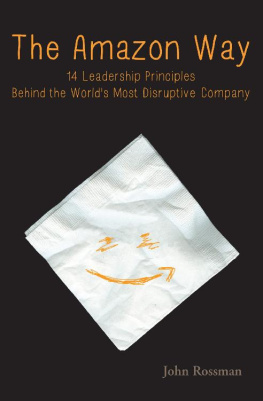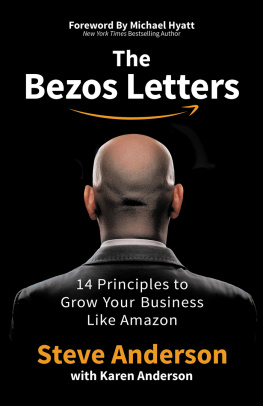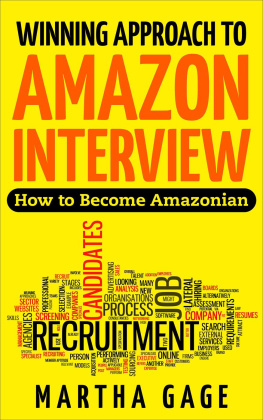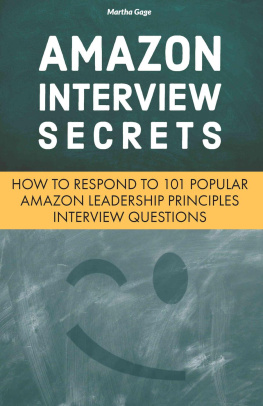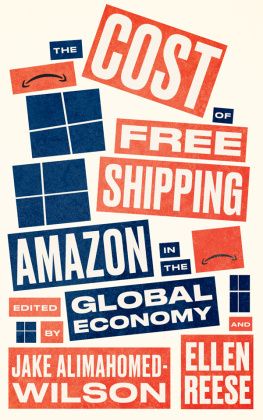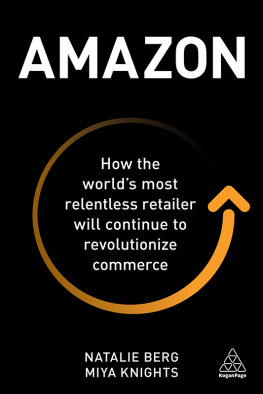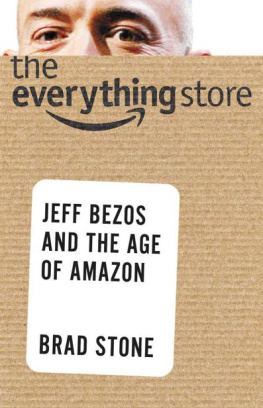The Amazon Way
14 Leadership P r inciples Behind the Worlds
Most Dis r upti v e Company
John Rossman
Copyright 2014 by John Rossman Authored with Ryan Masters
Contributions by Clifford Cancelosi
Contributions by Randy Miller Edited by Karl Weber All rights reserved.
ISBN: 1499296770
ISBN 13: 9781499296778
Library of Congress Control Number: 2014905059 LCCN Imprint Name: CreateSpace Independent Publishing Platf orm, North Charleston, S.C.
Cont e nts
Foreword v
Introduction 1
- Obsess Over the Customer 7
- Take Ownership of Results 25
- Invent and Simplify 32
- Leaders Are RightA Lot 51
- Hire and Develop the Best 61
- Insist on the Highest Standards 67
- Think Big 72
- Have a Bias for Action 80
- Practice Frugality 85
- Be Vocally Self-Critical 90
- Earn the Trust of Others 95
- Dive Deep 100
- Have BackboneDisagree and Commit 107
- Deliver Results 110
Conclusion 111
Appendix A: Future Ready Self-Service 11
Appendix B: Free Cash Flow 130
Appendix C: The Critical Capabilities of Building and
Operating a Platform Company 139
Acknowledgements 154
Sources
For e word
by Julie Weed
To hundreds of millions of people around the world, Amazon.com is a household name. But few know the inside story of how Amazon became the seemingly unstoppable powerhouse it is today. What was it like to work there as the company blossomed, successfully opening up more than a dozen new retail categories and outgrowing its headquarters in downtown Seattle? What made it possible for Amazon to transition from an online retailer to the inventor of a selling platform for all kinds of other companies and products, exponentially increasing its own reach and becoming the go-to store for almost any imaginable consumer product?
John Rossman was there during that critical period, and in this book, hell tell you how it about the leadership culture behind it all.
From the beginning, starting with his 1997 Letter to Shareholders, Amazon founder Jeff Bezos has focused on the long term, on reinventing the customer experience, and on perfecting the technologies that would make it all possible. Over time, a set of leadership principles emerged and were used to make smart strategic decisions and accurate everyday choices.
These principles arent slogans printed on wall posters and coffee mugs. They are lived and breathed every day by Amazonians from the CEO on down. They are principles that other companies, small or large, may just want to adopt.
v
Every department at Amazon, from the mailroom to
the tech team responsible for the Kindle book delivery system, has a year-over-year improvement plan. How will we get better? What does the customer want from us? How can we use new technology to improve the customer experience? Lots of companies aspire to innovate, to create more value for customers. At Amazon, making that happen is ingrained in the corporate psyche. And this innovation mentality is just one of the principles that have enabled the company to outgrow its competitors and consistently surprise the best of the business world.
Now you can journey back in time to Amazons early days of crazy growth, continual reinvention, and wild (but never thoughtless) experimentation. John Rossman offers both an insiders view of Amazons history and an insightful analysis of the leadership principles that have helped Jeff Bezos own Americas shopping list. Just turn the page.
Julie Weed is a freelance writer who covers the world of business for The New York Times and other publications. Her national best-seller, All I Really Need to Know in Business I Learned at Microsoft, has been published in 12 languages.
vi
Introduction
I t is January, 2003. With less than a year under my belt as Amazon.coms director of merchant integration, I am still considered the new guy on the block. At the moment, I am sitting in a conference room in the companys Seattle headquarters, surrounded by whats called the S-Team, a group that includes Amazons 20 most senior executives, and I happen to be the center of attention. Unfortunately, this is because the founder and CEO, Jeff Bezos, is frustrated.
The answer to that question begins with a number! he
roars.
All eyes had turned in my direction when Jeff asked me a deceptively simple question: How many merchants have launched since the first of the year?
The question had puzzled me, since at the moment there simply arent any third-party sellersmerchants, in Jeffs parlanceto launch, which was out of my direct control. A bit apologetically, I responded, Well, you see, as of right now
Before I could finish, Jeff had erupted. The answer to
that question begins with a number!
Jeffs reputation for pyrotechnic displays of emotion is al
ready part of his legend. Jeff Bezos doesnt worry about your feelings; he doesnt give a damn whether or not youre having a good day. He only cares about resultsand theyd better be the right results. Everyone who joins Amazon.com understands this; its part of the deal. But this is the first time Ive found myself at the business end of his double-barreled fury, and Im more than a little shell-shocked by the experience. I hesitate, frantically juggling possible responses in my
head. Finally, taking a big gulp, I offer the simple answer he is asking for: Six, but
Jeff pounces like a lion tearing into the soft underbelly of
its kill. That is the most pathetic answer I have ever heard!
The ensuing rant is neither a simple exercise in humilia
tion nor some sort of power play designed to reinforce Jeffs status as the alpha dog of Amazon.com. Its an educational exercise that uses my situation as an opportunity to set an example and to transmit a series of cultural, strategic, and operational messages to the leaders of the company. The lecture is classic Jeff because, despite its thunderous volume and tone, it contains valuable lessons about the principles that define Amazon.com. In the next five minutes, Jeff touches on a half dozen of these principles as he describes my shortcomings in painful detail. I am chastised for my failure to sufficiently obsess over the customer, for not taking complete ownership of my project and its outcomes, for not setting higher standards for myself and my team, for not thinking big enough, for not possessing a bias for action, and for not being firmly and vocally self-critical when it was clear my performance was lacking. Throughout, I am pinned to my chair as if by a hurricane-force gale.
When Jeffs rant finally ends, he simply leaves the room
without another word and, just like that, the S-Team meeting has ended. As I allow myself to start breathing again, processing what has just happened, I notice that many of the other senior leaders are smiling at meand not unkindly. A few make a point of congratulating me as they gather their things and file out of the conference room.
He likes you, one explains with a pat on the shoulder. He wouldnt take the time to embarrass you like that if he didnt.
I ntr odu ction
In a fog, I stumble from the conference room, clutching
my notes and half-wondering how it is that I am still employed. How can anyone possibly withstand the white-hot crucible of Jeffs expectations? I wonder.
The key, of course, is right in front of my nose. In fact, its publicly available on the Amazon.com site if you know where to look. 1 And in that 2003 meeting, Jeff was all but hitting me over the head with it: The 14 leadership principles that drive Amazon, from top to bottom. Ive edited a bit of the language of the leadership principles for readability.
Next page
